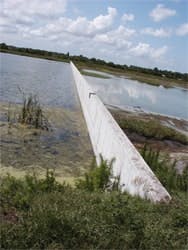The Michigan Avenue Wastewater Treatment Plant in the city of St. Cloud, Fla., was in need of help. In order to ensure that the plant’s reuse water meets strict EPA requirements, the city turned to Amiad Filtration Systems for help.
Like other municipal wastewater treatment plants, the Michigan Avenue facility produces reuse water that must meet EPA permitted suspended solids requirements. However, in order to facilitate demand swings in the reuse distribution systems, water is stored in retention reservoirs (see reservoir photo). These water bodies are exposed to natural elements that add organic suspended solids such as algae, protozoa, crustacean, fish, and other problematic contaminants. Unlined containment areas can also produce inorganic matter through wave action and rain run off consisting of sand, silts, and clays. Typically, the larger suspended solids are most troubling and are the main cause for plugging water emission devices used on golf courses, gated communities and commercial irrigation systems.
Therefore, in order to ensure that the facility would comply with EPA demands, the city of St. Cloud needed to make a change. The Michigan Avenue plant went with the expanded 20.25 mgd water reuse system from Amiad . The decision to use this filtration system was based on the experience of a smaller, successful operating system installed in October 2003.
The system
The self-cleaning, automatic system utilizes six model EBS-10,000 units with a filtration degree of 200 microns. The cleaning mechanism consists of a suction scanner “focus back-flush” technology, which uses simple physics for cleaning ( Fig. 1 ). The cleaning nozzle is designed within close tolerances to the cylindrical screen for high efficiency of back-flushing.
During a back-flush cycle, water moves both tangentially and directly into the orifice of the nozzle due to the large difference between operating and atmospheric pressures.
Expanding this concept further ( Fig. 2 ), the high velocity (50ft/sec) combined with the spiral movement of the nozzle(s) across every square inch of screen area effectively removes the entire filter cake without any interruption of flow through the filter units. Typically, back-flushing wastewater is less than 1% of total flow.
The suction scanner and screen media technology successfully removes the filter cake composed of these constituents at levels five times smaller then the water emission device. This level of filtration prevents smaller agglomerating particles from bridging the cross-section of the discharge orifice.
The system’s four-layer construction ( Fig. 3 ) consists of 316L stainless steel material with two 3,000 micron layers encapsulating and protecting the fine filtration degree layer from abrasion or impact from unexpected foreign objects. There is no permanent bonding or sintering of the layers, which allows the fine filter to float between the layers becoming a 100% effective area for water to pass through. Media with high percentages of effective area proportionally contain high dirt holding capacity of the system. The higher dirt holding capacity coupled with an efficient cleaning method provides the lowest capital investment, maintenance and operation costs.
The outside and final layer is a wedge-wire configuration encompassing the entire assembly forming its cylindrical shape. The total composite has been tested to withstand a differential pressure greater than 280 psi without any distortion or compromised integrity.
The self-cleaning filter consumes very little energy to operate; a standard one minute flushing cycle requires the rotation of the cleaning scanner by a fractional horse power motor drawing 0.5 amps at 220/440 VAC 3-Ph power. The initiation of the cleaning cycle occurs when either a pressure differential of 5-7 psi is reached, or a timer option has been set.
In all, the city of St. Cloud is pleased with the results brought forth from the Amiad water reuse system. The simplicity of design, low operating costs, and low maintenance requirements, all contribute to a reliable filtration process.
Steve Fournier is the eastern U.S. regional manager for Amiad Filtration Systems. He can be reached at (800) 969-4055 or by email at [email protected].

